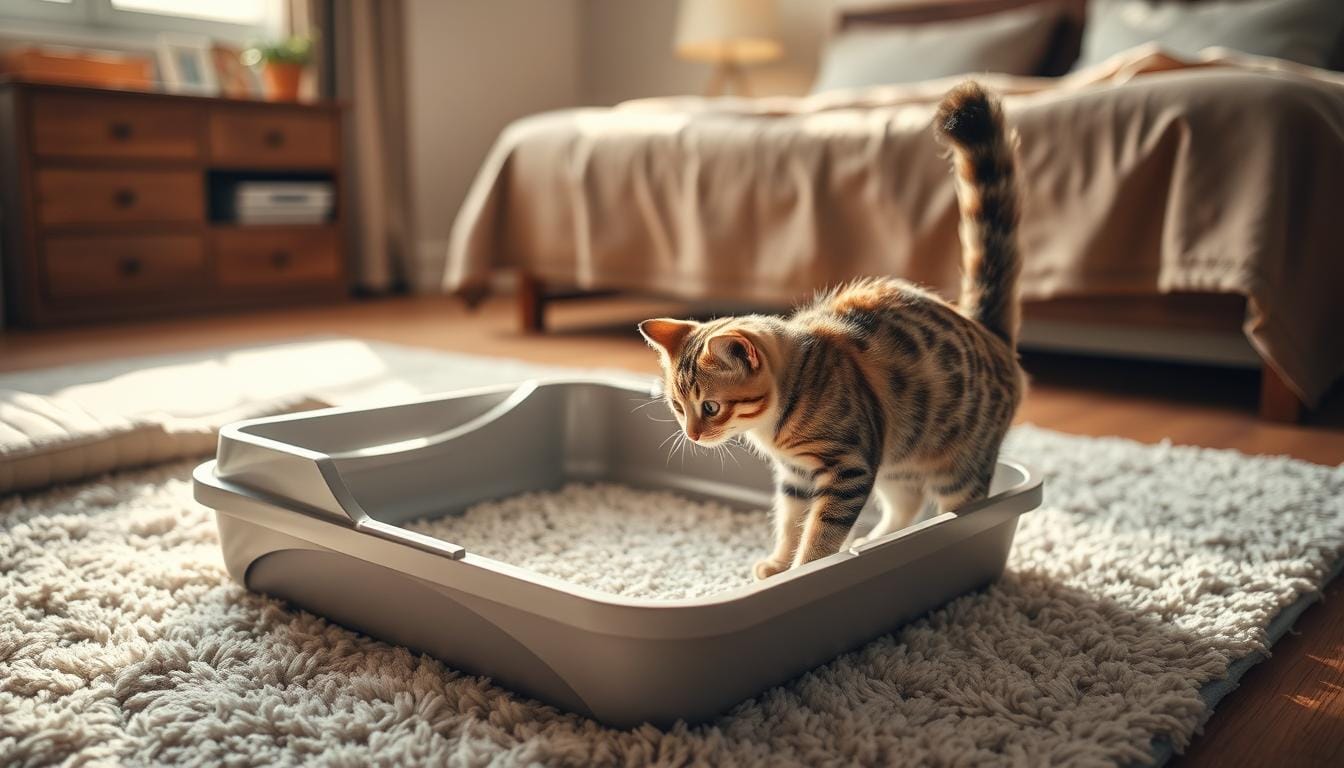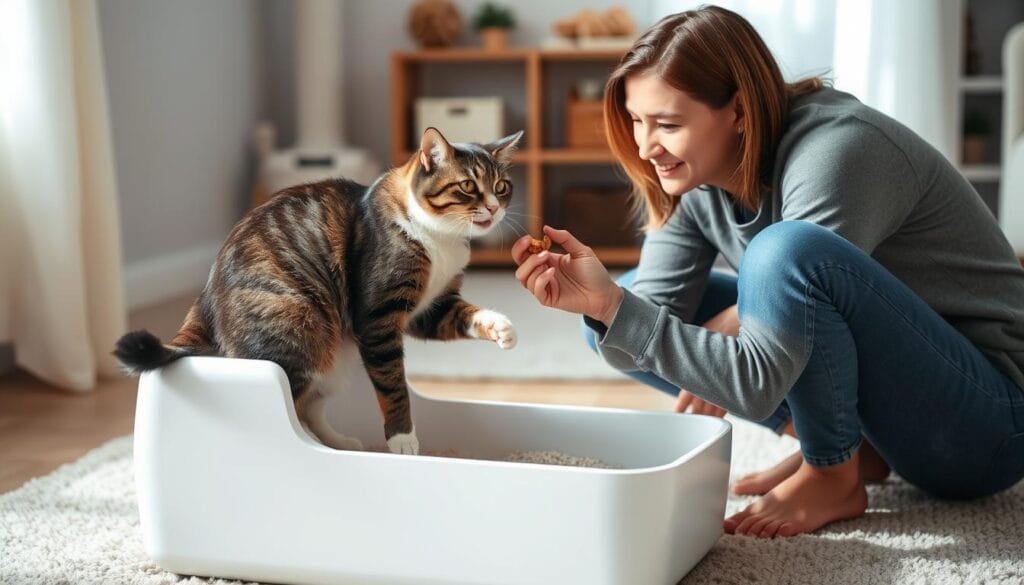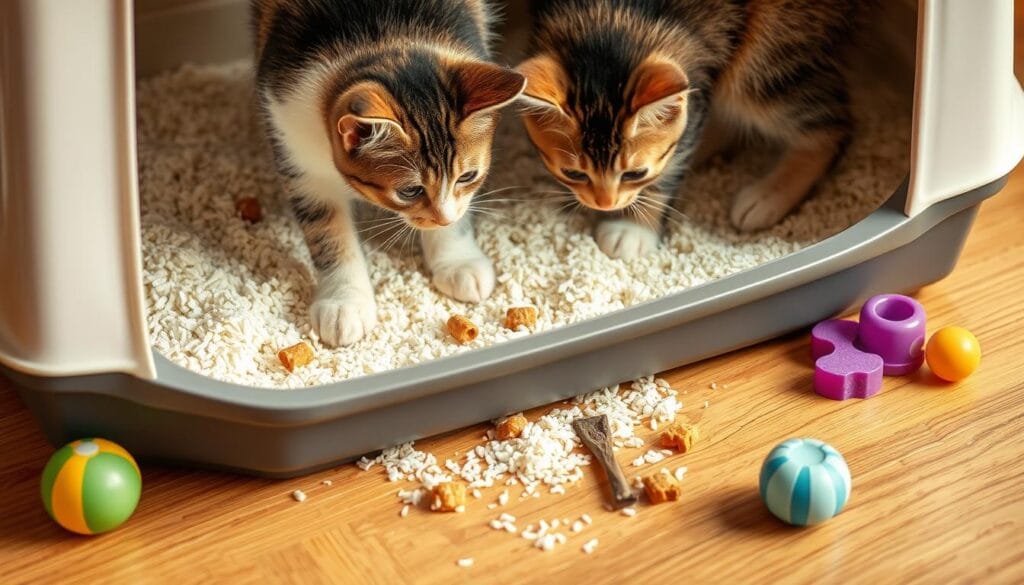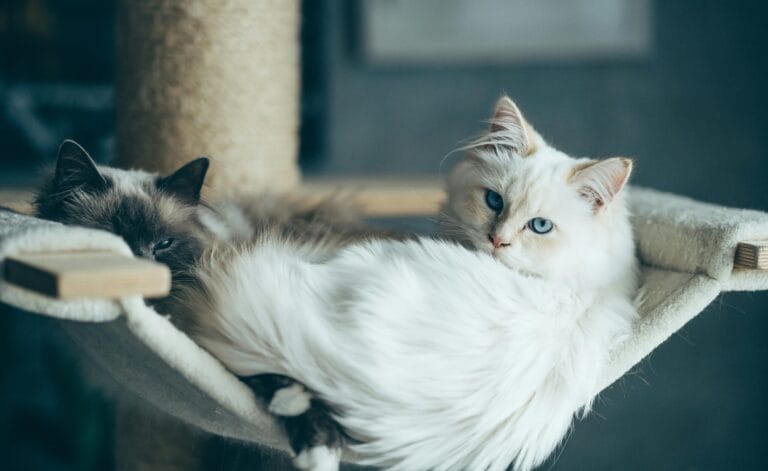How to Train Cat to Use Kitty Litter Fast in 3 Simple Days

Are you tired of the constant mess and hassle of having a cat that hasn’t learned to use the litter box properly? How to train cat to use kitty litter is a crucial aspect of cat ownership, and it’s easier than you think. With the right approach, your cat can learn to use the kitty litter in no time.
Effective litter box training not only improves your cat’s hygiene but also strengthens the bond between you and your pet. By dedicating just a few minutes each day to training, you can achieve remarkable results in as little as three days.
Table of Contents
Understanding Cat Litter Box Behavior
Feline litter box behavior is a complex interplay of natural instincts, preferences, and age-related factors. Cats‘ interactions with litter boxes are influenced by their wild ancestors’ habits, making it essential to understand these behaviors when learning how to train cat to use kitty litter successfully.
Natural Instincts and Preferences
Cats have inherent behaviors that affect their litter box usage. Two significant aspects are their digging and burying behaviors, as well as their need for privacy and security.
Digging and Burying Behaviors
How to Train Cat to Use Kitty Litter effectively starts with understanding their natural instincts. In the wild, cats dig and bury their waste to conceal their scent from predators. This instinctual behavior is still present in domesticated cats, making them inclined to dig in litter and cover their waste. Providing a litter that facilitates easy digging can encourage proper litter box use.
Privacy and Security Needs
How to Train Cat to Use Kitty Litter involves creating a comfortable environment that aligns with a cat’s natural preferences. Cats value their privacy, especially when using the litter box. They prefer quiet, secluded areas where they feel safe and secure. Placing the litter box in a low-traffic area can help reduce stress and make the cat more comfortable using it.
Common Reasons Cats Avoid Litter Boxes
Despite their natural instincts, cats may avoid using the litter box due to various reasons. Common issues include:
- Dirty or unhygienic litter conditions
- Inadequate litter box size or type
- Unfavorable location or accessibility
- Medical issues or discomfort
Addressing these issues can significantly improve a cat’s willingness to use the litter box.
Age Considerations for Training
The age of a cat plays a significant role in litter box training. Different life stages present unique challenges and opportunities.
Kittens vs. Adult Cats
Kittens are generally more receptive to litter box training due to their developmental stage. Adult cats, while still trainable, may require more patience and consistent reinforcement.
Senior Cat Challenges
Senior cats may face challenges such as decreased mobility or cognitive decline, which can affect their litter box behavior. Adjusting the litter box environment, such as using a litter box with lower sides, can help accommodate older cats.
Essential Supplies for Successful Litter Training
How to Train Cat to Use Kitty Litter begins with choosing the right supplies. The key to successful litter training lies in having the appropriate equipment, which can make a significant difference in how quickly and effectively your cat learns to use the litter box.
Choosing the Right Litter Box
Selecting a litter box that meets your cat’s needs is crucial. Consider the size and depth of the litter box, as well as whether it is covered or uncovered.
Looking for the Best Litter Boxes to Train Your Cat?
We’ve handpicked a collection of top-rated litter boxes on Amazon that make training easier, cleaner, and more comfortable for you and your cat.
👉Click Below to Find the Perfect Box for Your Furry Friend
Size and Depth Considerations
When considering how to train cat to use kitty litter, it’s important to ensure the litter box is large enough for your cat to turn around comfortably. The depth of the litter is also important; it should be deep enough to allow your cat to dig but not so deep that it’s difficult to access.
Covered vs. Uncovered Options
Some cats prefer the privacy of a covered litter box, while others may feel trapped. Observing your cat’s preferences can help you decide between covered and uncovered options.
Selecting Appropriate Cat Litter
The type of cat litter used can significantly impact litter training success. You can choose between clumping and non-clumping litter, as well as scented or unscented varieties.
Clumping vs. Non-Clumping
Clumping litter forms clumps when it comes into contact with moisture, making it easier to scoop out waste. Non-clumping litter, on the other hand, requires more frequent changing.
Scented vs. Unscented
Scented litter can help control odors, but some cats may be sensitive to strong fragrances. Unscented litter is a safer choice for cats with sensitivities.
Additional Tools and Accessories
In addition to a litter box and cat litter, other tools can aid in litter training. These include litter scoops, mats, and odor control solutions.
Litter Scoops and Mats
Litter scoops make cleaning the litter box easier, while mats can catch stray litter particles, reducing mess.
Odor Control Solutions
Using odor control solutions can help minimize unpleasant smells, making the litter box a more pleasant place for your cat.
Preparing Your Home for Litter Training
How to Train Cat to Use Kitty Litter starts with preparing your home, a crucial step in litter training your cat, as it sets the stage for successful habits. A well-prepared environment helps reduce stress for both you and your cat, making the training process smoother.
Optimal Litter Box Placement
The placement of the litter box is critical for effective litter training. Cats prefer quiet, private areas for their litter boxes.
Quiet and Accessible Locations
An important part of how to train cat to use kitty litter is choosing a location that is easily accessible for your cat but also quiet and away from high-traffic areas. Avoid placing litter boxes near their food and water bowls, as cats often prefer to keep these areas separate.
Multiple Box Strategies for Larger Homes
When learning how to train cat to use kitty litter, it’s important to remember that for larger homes, having multiple litter boxes in different locations can make a big difference. A general rule of thumb is to have one litter box per cat, plus one extra. This strategy can help prevent accidents and make it easier for your cat to find a litter box when needed.
Creating a Comfortable Environment
A comfortable environment is essential for successful litter training. Ensure that your cat feels safe and relaxed in the areas where the litter box is located.
Limiting Access to Other Areas
To prevent accidents, it’s crucial to limit your cat’s access to areas where you don’t want them to eliminate. Temporary confinement techniques can be useful in the initial stages of training.
Temporary Confinement Techniques
Confining your cat to a small area with the litter box can help them learn to use it. As they become more reliable, you can gradually give them more freedom.
Blocking Off Inappropriate Elimination Spots
A key step in how to train cat to use kitty litter is identifying areas where your cat tends to eliminate inappropriately and blocking access to them. You can use barriers or baby gates to restrict access until your cat is fully trained.
By following these tips and creating a conducive environment, you can significantly improve the chances of successful litter training for your cat. Tips for teaching cat to use litter box effectively include being patient and consistent, as litter training can take time.
How to Train Cat to Use Kitty Litter: Pre-Training Steps
Before diving into the training process, it’s essential to lay the groundwork for successful litter box training. This foundational step ensures that your cat is well-prepared to learn and adopt the desired behavior.
Establishing a Routine
How to Train Cat to Use Kitty Litter effectively includes establishing a routine, which is crucial for litter box training. Cats thrive on predictability, so creating a schedule for feeding, playtime, and sleep helps your cat feel secure and develop good habits. A consistent daily routine also helps in timing the litter box introduction and training effectively.
Introducing Your Cat to the Litter Box
How to Train Cat to Use Kitty Litter involves a delicate process that requires patience and gentle guidance. Start by placing your cat in the litter box after meals or playtime when they are most likely to need it.
Gentle Placement Techniques
Gently place your cat in the litter box, allowing them to become familiar with the texture and smell of the litter. Make sure the litter box is clean and accessible.
Demonstrating Pawing Motions
To encourage your cat to dig and cover their waste, demonstrate pawing motions in the litter. This can be done by gently moving their paws or using your own hand to show the motion.
Positive Reinforcement Techniques
Positive reinforcement is a powerful tool in litter box training. Rewarding your cat for successful uses of the litter box encourages them to continue the behavior.
Treats and Rewards
Use treats and rewards immediately after your cat uses the litter box correctly. This positive association will help your cat understand that using the litter box is the desired behavior.
Verbal Praise and Affection
As part of how to train cat to use kitty litter, using treats, verbal praise, and affection can reinforce good litter box behavior. Cats respond well to positive verbal cues and physical affection, making them feel accomplished and encouraged to continue using the litter box.

Day 1: Initial Training Techniques
To successfully understand how to train cat to use kitty litter, start with a well-planned morning routine on day one. This involves introducing your cat to the litter box and encouraging its use through a series of gentle and effective techniques.
Morning Routine and First Introduction
A helpful step in how to train cat to use kitty litter is to begin by placing your cat in the litter box after breakfast. This after-meal box placement helps create an association between the litter box and the cat’s natural instinct to eliminate after eating.
After-Meal Box Placement
Gently place your cat in the litter box immediately after meals to create a connection between the act of eating and the need to eliminate.
Waking and Nap Time Opportunities
Also, take advantage of your cat’s natural waking and nap times to introduce them to the litter box, as these are typical times when cats look to eliminate.
Monitoring and Guidance Techniques
It’s crucial to monitor your cat’s behavior closely on the first day. Watch for pre-elimination behaviors such as sniffing or circling, which indicate that your cat needs to use the litter box.
Recognizing Pre-Elimination Behaviors
Recognize the signs that your cat is about to eliminate, such as restlessness or sniffing around. Quickly guide them to the litter box.
Gentle Redirection Methods
If your cat shows interest in eliminating outside the litter box, gently redirect them to the box. Avoid scolding or punishing, as this can create negative associations.
Evening Reinforcement Strategies
As the day comes to a close, reinforce the litter box behavior with consistent reward systems. Praise or reward your cat when they use the litter box correctly.
Consistent Reward System
Use treats or praise to reward your cat for successful uses of the litter box. Consistency is key to reinforcing good behavior.
Overnight Preparation
Before bed, ensure the litter box is clean and easily accessible. This preparation helps your cat continue to use the litter box through the night.
| Training Aspect | Technique | Benefit |
|---|---|---|
| Morning Introduction | After-meal box placement | Creates association between meals and litter box use |
| Monitoring | Recognizing pre-elimination behaviors | Helps in guiding the cat to the litter box |
| Evening Reinforcement | Consistent reward system | Reinforces good litter box behavior |
Day 2: Reinforcing Litter Box Habits
On the second day of how to train cat to use kitty litter, the goal is to strengthen your cat’s understanding of using the litter box correctly. The focus is on reinforcing the litter box habits established on the first day.
Expanding Access While Maintaining Focus
On day two, you can start expanding your cat’s access to more areas of your home while maintaining focus on the litter box. This involves a couple of key strategies:
Gradual Space Introduction
Begin by allowing your cat to explore one or two more rooms, ensuring that the litter box remains easily accessible. Supervise your cat’s movement to prevent accidents.
Maintaining Box Visibility
Make sure the litter box is not hidden from view. Cats prefer to have a clear path to the litter box, so keep it in a visible location.
Addressing Initial Resistance or Accidents
Some cats may show resistance to using the litter box or have accidents outside of it. It’s essential to address these issues promptly.
Proper Cleaning Techniques
If your cat has an accident, clean the area thoroughly with a pet-safe cleaner to remove any lingering scents that might attract your cat to the same spot again.
Adjusting Box Location if Needed
If your cat continues to avoid the litter box, consider relocating it to a quieter area or adjusting its size to better suit your cat’s needs.

Progress Assessment and Adjustments
Assessing your cat’s progress on day two is crucial to making necessary adjustments to the training plan.
Tracking Success Rates
When learning how to train cat to use kitty litter, keep a log or mentally note how often your cat uses the litter box correctly versus having accidents. This will help you understand your cat’s learning curve.
Modifying Approach Based on Results
If you notice that your cat is having trouble, adjust your training approach. This might involve changing the litter type, box location, or increasing supervision.
- Monitor your cat’s litter box behavior closely.
- Be prepared to make adjustments as needed.
- Maintain a clean and accessible litter box.
Day 3: Solidifying Training Success
As you enter the final day of how to train cat to use kitty litter, it’s essential to reinforce the habits your cat has learned. By now, your cat should be familiar with the litter box and have established a routine. The goal of day three is to solidify this training, ensuring your cat continues to use the litter box correctly even with more freedom around the house.
Increasing Freedom Around the House
An important part of how to train cat to use kitty litter is giving your cat more space to roam while maintaining supervision. This can be achieved through supervised exploration, allowing your cat to discover new areas of the house while ensuring they understand that the litter box remains the designated area for elimination.
Supervised Exploration
Begin by allowing your cat to explore one new room at a time, under close supervision. This helps in preventing accidents and reinforces the litter box habit.
Distance Testing from Litter Box
A key technique in how to train cat to use kitty litter is to gradually increase the distance between your cat and the litter box during supervised exploration. This tests their understanding of the litter box’s purpose and helps in solidifying the training.
Final Reinforcement Techniques
As your cat becomes more confident in using the litter box, it’s time to adjust your supervision and reward strategies.
Decreasing Direct Supervision
Start reducing direct supervision while still keeping a watchful eye. This helps your cat learn to use the litter box independently.
Maintaining Consistent Rewards
As part of how to train cat to use kitty litter, continue to reward your cat for successful uses of the litter box. Consistency in rewards reinforces good behavior.
Signs of Successful Training
Successful litter box training is evident when your cat consistently uses the litter box without supervision.
Independent Box Usage
Your cat should be able to use the litter box without your direct involvement, indicating a strong understanding of its purpose.
Consistent Elimination Patterns
A consistent elimination pattern, where your cat uses the litter box for both urination and defecation, is a key indicator of successful how to train cat to use kitty litter.
| Signs of Successful Training | Description |
|---|---|
| Independent Box Usage | Cat uses the litter box without supervision. |
| Consistent Elimination Patterns | Cat consistently uses the litter box for elimination. |
By following these steps and reinforcing good habits, you can ensure your cat remains trained in using the litter box. As stated by cat behaviorists, “Consistency and positive reinforcement are key to successful litter box training.”
“Consistency and positive reinforcement are key to successful litter box training.”
Troubleshooting Common Litter Box Issues
Even after successfully mastering how to train cat to use kitty litter, other problems might surface. Despite initial success, cat owners may encounter various litter box issues that require attention and resolution.
Dealing with Accidents Outside the Box
Accidents can happen even with well-trained cats. It’s essential to address these incidents properly to prevent future occurrences.
Proper Cleaning to Remove Odors
Part of how to train cat to use kitty litter involves addressing accidents promptly. When accidents happen, thorough cleaning is crucial to remove any lingering odors that might attract your cat to the same spot again. Use a cleaner that eliminates odors rather than just masking them.
Identifying Accident Patterns
A vital aspect of how to train cat to use kitty litter is observing your cat’s behavior to identify any patterns in their accidents. This can help you understand if there’s a specific reason, such as medical issues or litter box dissatisfaction.
Addressing Box Avoidance Behaviors
Sometimes, cats avoid using their litter box due to various reasons. Understanding these reasons is key to resolving the issue.
Litter Type Preferences
Cats may have preferences for certain types of litter. Experimenting with different litter types can help you find one that your cat prefers.
Box Cleanliness Issues
Ensure the litter box is cleaned regularly. Cats are very particular about hygiene, and a dirty litter box can be a significant deterrent.
| Issue | Possible Cause | Solution |
|---|---|---|
| Accidents Outside Box | Medical Issues or Odor Attraction | Proper Cleaning, Veterinary Check-up |
| Box Avoidance | Litter Type or Box Cleanliness | Change Litter Type, Increase Cleaning Frequency |
When to Consult a Veterinarian
If your cat continues to have litter box issues despite your best efforts to resolve them, it may be time to consult a veterinarian.
Medical Issues That Affect Litter Box Use
Certain medical conditions can cause cats to avoid their litter box. A veterinarian can help diagnose any underlying health issues.
Behavioral Problems Requiring Professional Help
In some cases, litter box issues may arise even after learning how to train cat to use kitty litter, signaling deeper behavioral problems. A professional can provide guidance on how to address these issues.
By understanding and addressing common litter box issues, cat owners can create a more harmonious and healthy environment for their pets.
Maintaining Long-Term Litter Box Success
To keep your cat using the litter box, maintenance is key. A clean and welcoming litter box environment is crucial for the long-term success of your cat’s litter training.
Regular Cleaning Schedule
A regular cleaning schedule is vital. This includes daily scooping and periodic complete changes of the litter.
Daily Scooping Routine
Scooping out solid waste daily prevents the buildup of bacteria and odor, making the litter box a more pleasant place for your cat.
Complete Box Changes
Changing the litter completely every 7-10 days, depending on the type of litter and the number of cats using it, ensures a clean environment.
Adjusting to Environmental Changes
Cats are sensitive to changes in their environment. Adjusting the litter box setup or location in response to changes like moving to a new home or adding new pets can help maintain litter box usage.
Moving to a New Home
When moving, keep the litter box in a quiet, accessible location to reduce stress on your cat.
Adding New Pets
Gradually introduce new pets to the litter box area to prevent territorial behavior.
Ongoing Positive Reinforcement
Continuing to reward your cat for using the litter box correctly reinforces good behavior.
Maintaining Consistency
Consistency in cleaning and rewarding helps maintain the habits you’ve established.
Addressing Regression Issues
If your cat starts to avoid the litter box or has accidents, address the issue promptly by checking the litter box cleanliness and your cat’s health.
| Maintenance Task | Frequency | Importance |
|---|---|---|
| Scooping | Daily | High |
| Complete Litter Change | Every 7-10 days | High |
| Litter Box Cleaning | During complete litter change | High |
Looking for the Best Litter Boxes to Train Your Cat?
We’ve handpicked a collection of top-rated litter boxes on Amazon that make training easier, cleaner, and more comfortable for you and your cat.
👉Click Below to Find the Perfect Box for Your Furry Friend
Sources:
https://www.hituponviews.com/how-to-train-your-cat-to-use-a-litter-box-tips-and-tricks/?
https://www.smalldoorvet.com/learning-center/behavior/litter-train-cat?
https://www.everhartvet.com/how-to-litter-train-a-cat/?
https://www.catster.com/cat-behavior/how-to-train-your-kitten-to-use-the-litter-box/?
https://www.thesprucepets.com/how-to-solve-cat-litter-box-behavioral-issues-5190151?
https://www.greencrossvets.com.au/pet-library/articles-of-interest/5-steps-to-toilet-train-your-cat/?
https://independenceveterinaryclinic.com/how-to-train-your-cat-to-use-the-litter-box-tips-and-tricks/?
Conclusion
Training a cat to use a kitty litter box is a straightforward process when broken down into manageable steps. By following the three-day training process outlined, cat owners can establish good litter box habits and enjoy a cleaner, healthier home.
The key to successful litter box training lies in understanding cat behavior, selecting the right equipment, and consistently reinforcing positive habits. By day three, most cats will have learned to use the litter box reliably, making it an essential part of their daily routine.
To maintain long-term litter box success, it’s crucial to continue reinforcing good habits and addressing any issues promptly. Regular cleaning, adjusting to environmental changes, and ongoing positive reinforcement are vital components of a well-functioning litter box training regimen. By mastering how to train a cat to use kitty litter, cat owners can create a harmonious and hygienic living environment for both themselves and their feline companions, utilizing effective litter box training and cat litter training techniques.



